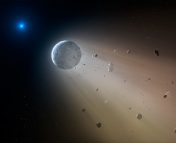Title: A 5.3-minute-period pulsing white dwarf in a binary detected from radio to X-rays
Authors: Ingrid Pelisoli, T. R. Marsh, David A. H. Buckley, et al. (19 additional authors)
First Author’s Institution: Department of Physics, University of Warwick
Status: Published in Nature Astronomy (closed access)
In 2016, our conception of white dwarf stars was turned on its head with the discovery of AR Scorpii, the first confirmed white dwarf pulsar. AR Scorpii (or, AR Sco for short) was found to emit regular pulsations every 1.97 minutes, which spanned the majority of the electromagnetic spectrum. These pulsations appeared to be synchrotron emission created by highly accelerated electrons, which typical white dwarfs don’t produce– we tend to observe only thermal radiation around optical wavelengths from white dwarfs as they cool. The emission properties of Ar Sco led the authors of the original paper to conclude that Ar Sco was the first white dwarf pulsar. Like the rest of the pulsar population, AR Sco is highly magnetized and powered by its rotation, but of the over 2,000 known radio pulsars, every other pulsar is a neutron star.
For years, Ar Sco was the only confirmed member of its ‘family’– making its discovery extremely exciting, but also making it very difficult to understand how it works. We typically assume that pulsars convert their kinetic energy to radiation, and calculate how much energy a pulsar can put into emission (its ‘spin down luminosity’) based on the rate of change of its rotation. While the original paper reported a spin-down rate for AR Sco, recent studies have suggested that we can’t accurately measure a spin-down rate that isn’t consistent with zero with the data we have so far. Without a statistically significant measurement of its spin-down rate, we’re not really sure where the white dwarf pulsar gets the energy to create its emission.
Furthermore, we’re not even sure how exactly AR Sco evolved to its present state. It rotates so much faster than typical white dwarfs that we’re pretty confident it went through a period of accretion, where material from its binary companion landed on the white dwarf and increased its angular momentum. On the other hand, its emission properties suggest that it has a very strong magnetic field– so strong, in fact, that it should theoretically repel most material away from it, not allowing for sufficient accretion! We clearly needed to find more pulsars of this type to understand what makes them tick.
Double Trouble: The Second White Dwarf Pulsar

Today’s paper presents the second confirmed white dwarf pulsar, J1944-4410 (a much less catchy name!). The authors obtained observations of dozens of optical sources which had properties similar to AR Sco, being variable sources with similar colors and magnitudes in optical and infrared wavelengths. So far, the pulsar announced in today’s paper (J1944) is the only confirmed white dwarf pulsar from this search.
J1944 is in a 4-hour binary orbit with a red dwarf star– the same companion type as AR Sco. Using observations of the system from several observatories, and archival data from NASA’s Transiting Exoplanet Survey Satellite (TESS), the authors observed periodic changes in the brightness of the system which indicated the binary nature of the system, with an orbital period of 4 hours (shown in Figure 1).
In addition to the effects of the binary orbit, the emission from the system shows clear periodic oscillations (left panel of Figure 2). These periodic pulses are visible at all observing frequencies, from radio wavelengths to X-rays. These pulses appear at a regular interval of 5.4 minutes, while the longest-period neutron star pulsar has a period of 76 seconds– adding evidence that this is a unique white-dwarf pulsar. Like AR Sco, J1944’s total luminosity is much higher than can be explained by stellar emission from the dwarf companion, adding further evidence that the emission is powered by the spin-down of the white dwarf, though we haven’t observed J1944 long enough to confidently measure a spin-down rate.

The right panels of Figure 2 show the average pulse shapes from J1944 across the electromagnetic spectrum. Two distinct pulse components can be seen (best in panel g), a narrow and broad component. The narrow component, most visible at lower frequencies, is similar to the short pulsed emission seen in radio pulsars, while the broad component is likely caused by the interaction of the white dwarf’s magnetic field with the stellar companion.

Perhaps the most promising finding from today’s paper is a single bright burst of emission, lasting only a few minutes, which does not seem to be associated with either of the easily identifiable pulse components described above (see Figure 3). Since it’s a single bright burst which never repeats, the authors interpret it as a flare, caused by material from the companion star falling onto the white dwarf pulsar. Remember that in AR Sco, there was no evidence of accretion, despite the expectation that material must have accreted onto the white dwarf pulsar in order for it to spin as fast as we observe. This single flare lends evidence to the theory that accretion does happen early in the lives of white dwarf pulsars, but eventually stops– so, J1944 could be earlier along in its evolutionary lifetime than AR Sco, truly making it the younger sibling!
Astrobite edited by Lindsay DeMarchi
Featured image credit: Casey Reed, NASA Goddard Space Flight Center




